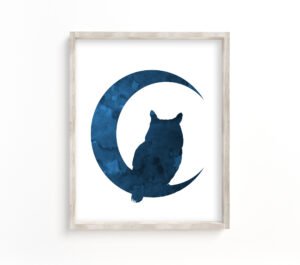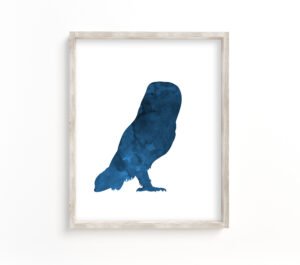
A group of owls is called a parliament
A group of birds, including owls, is actually called a flock of birds.
The term parliament for a group of owls may come from pop culture (in the chronicles of Narnia, owls were referred to as a parliament) or mythology, where owls are often seen as intelligent and wise.
Hey, you’re still not wrong if you call them a flock of birds!
Baby owls are called owlets
Owls lay up to 12 eggs, depending on the species, but most lay 3-4 eggs. Feeding 12 owlets at the same time must be hard work – could you imagine caring for 12 children at once?
Almost all Owls are nocturnal
That’s what they’re famous for. Owls have perfect eyes for hunting in the darkness at night. And then, there’s the burrowing owl, who doesn’t care about day and night at all – and just stays up whenever it wants.
Owls are birds of prey...
… and hunt small mammals and insects. Some owls even hunt fish. Some owls consume 1000 mice within a year. A barn owl family may consume about 3000 small mammals like mice, rats, and rabbits within one nesting season. And they also accept other small animals like frogs or insects on their dinner table. Eagle owls even catch small deer! For real!
Owls swallow their prey as a whole and swallow up none digestible parts like fur in small pellets.
There are over 200 different owl species known
And almost all of them hunt small animals at night, have a plumage that blends in with their environment, binocular vision, and a binaural hearing.
They can rotate their neck as much as 270°
If we humans would try doing the same, we would pass out and injure ourselves badly. Owls, however, have a more flexible neck and a circulatory system that allows the head and neck to rotate without cutting off blood to the brain.
Owls have superior eyes
Having large eyes compared to their skull creates a mysterious look, but there’s more than meets the eye! Owl eyes are tubular-shaped – which is often seen in nocturnal animals – and they’re farsighted. Perfect for hunting small animals at night! Owls can’t move their eyes, though, and have to rotate their full head if they want to view their surroundings.
And they have superior ears as well!
The Perfect Cam-Owl-flage Plumage
Colors and patterns of owl plumage blend perfectly with their natural environment and make them invisible to prey. For instance, the snowy owl, native to arctic regions, has a plain white plumage to blend in with the snow, while owls native to forests have brown-speckled plumage to blend in with trees. Their feathers are perfectly evolved to fly silently.
The smallest owl...
The smallest owl is the elf owl (who often lives in old woodpecker cacti nests) – measuring about 5 1⁄4″ (13.5 cm) with a bodyweight of about 1.4 oz (31 grams)
The largest owl...
The largest owls are the Eurasian eagle-owl and the Blakiston’s fish owl. Both species can grow up to 28″ (71 cm) long with a 75″ (190 cm) wingspan, and a weight of 9 1⁄4 lb (4.2 kg)
Females are larger than males
It’s unknown why male owls are smaller than females. During the breeding season, the mother owl stays with its eggs while the father owl hunts for food. A smaller body may be an advantage when hunting small birds due to their higher agility. A smaller body needs less energy when hunting. Another theory suggests that females are bigger because it helps them to go a longer time without starving while providing food for their babies (owlets).
Owls are part of many mythologies
In Japan, owls are associated with luck, and many Japanese people wear owl charms and talismans. The modern West associates owls with wisdom, and in native American folklore, owls are a symbol of death.
Owls are natural pest control
Owl families are quite hungry. Let alone during nesting season a barn owl family can consume about 3000 small animals like mice, rats, and rabbits. Placing a nest box on a property may encourage owls to breed there and help naturally control vermins.
Burrowing owls smear the entrance of their borrows with animal dung
Ugh! Why would they do that? Burrowing owls smear the entrance of their borrows with animal dung because the smell attracts insects! That way, burrowing owls don’t have to leave their nests to hunt during the breeding season. Pretty clever, huh?
Most owls don't build their own nest
The burrowing owl, for instance, prefers to steal its burrow from ground squirrels. And barn owls prefer holes in trees or fissures in cliff faces (that’s why they are called cavity nesters). They also nest in old bird or squirrel nests.
-
 $20.00 – $29.00 inc. VatSelect options This product has multiple variants. The options may be chosen on the product page
$20.00 – $29.00 inc. VatSelect options This product has multiple variants. The options may be chosen on the product page -
 $20.00 – $29.00 inc. VatSelect options This product has multiple variants. The options may be chosen on the product page
$20.00 – $29.00 inc. VatSelect options This product has multiple variants. The options may be chosen on the product page -
 $20.00 – $29.00 inc. VatSelect options This product has multiple variants. The options may be chosen on the product page
$20.00 – $29.00 inc. VatSelect options This product has multiple variants. The options may be chosen on the product page -
 $20.00 – $29.00 inc. VatSelect options This product has multiple variants. The options may be chosen on the product page
$20.00 – $29.00 inc. VatSelect options This product has multiple variants. The options may be chosen on the product page